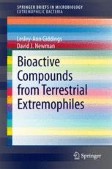Search
Search Results
-
Yeasts in Hypersaline Habitats
For a long time, halotolerant yeasts were known exclusively as contaminants of food preserved with high concentrations of salt or sugar. Their...
-
Growth and Metabolism of Extremophilic Microorganisms
Extremophiles are a group of organisms growing optimally in a wide range of extreme environments. They have the capability of using many different...
-
Concomitant osmotic and chaotropicity-induced stresses in Aspergillus wentii: compatible solutes determine the biotic window
Whereas osmotic stress response induced by solutes has been well-characterized in fungi, less is known about the other activities of environmentally...

-
Convergent evolution of highly reduced fruiting bodies in Pezizomycotina suggests key adaptations to the bee habitat
BackgroundAmong the understudied fungi found in nature are those living in close association with social and solitary bees. The bee-specialist genera

-
A century later: rediscovery, culturing and phylogenetic analysis of Diploöspora rosea, a rare onygenalean hyphomycete
Nearly 100 years after its first discovery, Diploöspora rosea was detected on biologically damaged parchment paper in Rome, Italy and isolated from...

-
The Genetic Basis of Abiotic Stress Resistance in Extremophilic Fungi: The Genes Cloning and Application
In eukaryotic organisms, many genera of fungi have successfully colonized various extreme environments known on earth. For example, some species...
-
Bioactive Compounds from Terrestrial Extremophiles
Since the 1960s, bioactive secondary metabolites have been isolated and structurally characterized from eubacteria, archaea, and fungi,...
-
Background on Vegetation Classification Systems
Vegetation is formed by plant species growing as the result of a long development process consistent with the places they inhabit and which...
-
Arachnids (Aranei, Opiliones) in meadows: Response to pollution with emissions from the Middle Ural Copper Smelter
Arachnids living in the herbaceous layer have been studied in 2006–2008 in secondary upland meadows along the gradient of pollution with emissions...
-
Is there a common water-activity limit for the three domains of life?
Archaea and Bacteria constitute a majority of life systems on Earth but have long been considered inferior to Eukarya in terms of solute tolerance....

-
Impacts of environmental stress on growth, secondary metabolite biosynthetic gene clusters and metabolite production of xerotolerant/xerophilic fungi
This paper examines the impact that single and interacting environmental stress factors have on tolerance mechanisms, molecular ecology and the...

-
Halophily reloaded: new insights into the extremophilic life-style of Wallemia with the description of Wallemia hederae sp. nov
Wallemia comprises air- and food-borne, mycotoxigenic contaminants including the halophilic W. ichthyophaga , xerotolerant W. sebi and xerophilic W....

-
5 Pezizomycotina: Eurotiomycetes
The class Eurotiomycetes is a morphologically and ecologically diverse clade of filamentous ascomycetes (Ascomycota; Pezizomycotina). Based on a...
-
Comparative study of actinomycete communities associated with Lasius niger and Formica cunicularia ants and their nests
A comparative analysis of the abundance and biodiversity of actinomycete communities isolated from living ants Lasius niger and Formica cunicularia ,...
-
Providing Habitats for Urban Insects
The more conspicuous vegetated areas in towns and cities, public parks and gardens, are major foci for both conservation and amenity use. They...
-
Xerochrysium gen. nov. and Bettsia, genera encompassing xerophilic species of Chrysosporium
On the basis of a study of ITS sequences, Vidal et al. ( Rev. Iber. Micol. 17 : 22, 2000) recommended that the genus Chrysosporium be restricted to...

-
Psychrotolerant antifungal Streptomyces isolated from Tawang, India and the shift in chitinase gene family
A total of 210 Streptomyces were isolated from the soil samples of Tawang, India where temperature varied from 5 °C during daytime to −2 °C during...

-
Testate amoebae and environmental features of polygon tundra in the Indigirka lowland (East Siberia)
Polygon tundra characterizes large areas of arctic lowlands. The micro-relief pattern within polygons offers differentiated habitats for testate...

-
Aspergillus penicillioides—a true halophile existing in hypersaline and polyhaline econiches
Aspergillus penicillioides is a true halophile, present in diverse econiches from the hypersaline athalassohaline Dead Sea and the thalassohaline...

-
Polyextremophiles and the Constraints for Terrestrial Habitability
Life on Earth occupies a multidimensional niche space that has yet to be fully described. The niche space of terrestrial life is knowable, and thus,...
